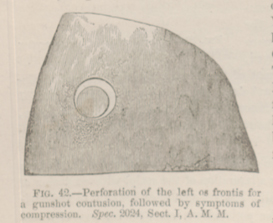Title: Attig, William
Source text: Surgeon General Joseph K. Barnes, United States Army, The Medical and Surgical History of the War of the Rebellion. (1861–65.), Part 1, Volume 2 (Washington, D.C.: Government Printing Office, 1870), 124.
Civil War Washington ID: med.d1e8920
TEI/XML: med.d1e8920.xml
ATTIG, WILLIAM, Private, Co. A, 49th Pennsylvania Volunteers, aged 25 years, was wounded, near Rappahannock Station, Virginia, November 7th, 1863, by a conoidal musket ball which struck the forehead near the left frontal eminence, denuding the bone of its periosteum for about one inch. He was conveyed to Washington, and admitted into Harewood Hospital on the 9th, complaining of slight headache over the region of the eyes. His pulse was normal, and his appetite poor. On the 17th, chills, with vomiting, supervened, and the eyes became lachrymose. These symptoms continued until the 19th, when he was anæsthetized, and Surgeon R. B. Bontecou, U. S. V., made a crucial incision through the scalp, when pus was found issuing through the denuded bone. The trephine was then applied near the left frontal eminence, giving exit to a small quantity of pus, which was found between the dura mater and the skull. After the operation, the patient became free from pain. During the night of the 20th, he became delirious, and lay in a stupor nearly all the time, but answered questions correctly. The next morning, the forehead and right eye-lids were œdematous, and the pulse was 75, and feeble. On the 23d, low muttering delirium followed, coma ensued, the alvine evacuations became involuntary, and his breathing stertorous. At eleven o'clock A. M. of the 24th, the dura mater was incised, giving exit to a small quantity of pus, but no relief was afforded, and death occurred two hours subsequently. The pathological specimen was sent to the Army Medical Museum, and is represented in the wood-cut (FIG. 42). It was forwarded, with its history, by Surgeon R. B. Bontecou, U. S. V.
